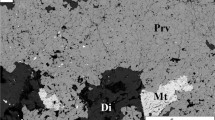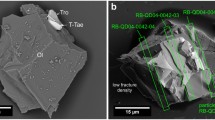Summary
A detailed TEM study of dusty plagioclase revealed for the first time that the dust materials are mainly composed of glass, alkali feldspar, quartz and other fine-grained minerals. Detailed textures and the chemistry of glass inclusions are also described. b-domains with smoothly curving boundaries are found in the dusty zone and the clear rim. The plagioclase in the dusty zone inverts from C\(\bar 1\) into I\(\bar 1\) by (1) annealing in a stable C\(\bar 1\) field and then quenching on eruption and, (2) compositional change from less calcic to more calcic during partial dissolution or (3) annealing in a metastable C\(\bar 1\) field. The calcic clear plagioclase rim crystallizes metastably as C\(\bar 1\) and then inverts into I\(\bar 1\) on eruption. The glass inclusions are more enriched in SiO2 (> 80 wt.%) than residual glasses in the groundmass. It is estimated that alkali feldspar, quartz and other fine-grained minerals were crystallized from the melts entrapped in the dusty zone during eruption. It is concluded that the dusty plagioclase was formed by the dissolution of less calcic plagioclase in basic magma during magma mixing.
Zusammenfassung
Eine detaillierte TEM-Studie von durchstäubtem Plagioklas zeigte erstmals, daß das Staubmaterial hauptsächlich aus Glas, Alkali-Feldspat, Quarz und anderen feinkörnigen Mineralphasen besteht. Weiters werden Details der Texturen, sowie der Chernismus von Glaseinschlüssen beschrieben. In der durchstäubten Zone und im klaren Rand des Plagioklases wurden b-Domäne mit sanft gebogenen Begrenzungen gefunden. Der Plagioklas in der durchstäubten Zone wandelt sich durch folgende Prozesse von C\(\bar 1\) in I\(\bar 1\) um: 1) durch Tempern in einem Stabilitätsfeld von C\(\bar 1\) und darauffolgender Abschreckung während der Eruption, und 2) durch Änderung der Zusammensetzung von weniger Careich zu mehr Ca-reich während partieller Auflösung, oder 3) durch Tempern in einem metastabilen C\(\bar 1\) Feld. Der Ca-reiche, klare Plagioklasrand kristallisiert als metastabile C\(\bar 1\) Phase und wandelt sich dann, während der Eruption, in die 11 Phase um. Die Glaseinschlüsse sind deutlich an SiO2 (> 80 wt.%) angereichert, verglichen mit Residualgläsern in der Grundmasse. Es wird vermutet, daß Alkali-Feldspat, Quarz und andere feinkörnigen Mineralphasen aus jener Schmelzphase kristallisiert sind, die während der Eruption in die durchstäubte Zone eingeschlossen worden ist. Es wird der Schluß gezogen, daß der durchstäubte Plagioklas durch Auflösung von Caärmeren Plagioklas in einem basischen Magma während Magmen-Mischung gebildet worden ist.
Similar content being viewed by others
References
Anderson AT (1984) Probable relations between plagioclase zoning and magma dynamics, Fuego Volcano, Guatemala. Am Mineral 69: 660–676
Carpenter MA (1988) Thermochemistry of aluminum/silicon ordering in feldspar minerals. In:Salje EKH (ed) Physical properties and thermodynamic behavior of minerais. NATO ASI series C255. Reidel, Boston, pp 265–323
Carpenter MA, McConnell JDC (1984) Experimental delineation of the C\(\bar 1\) ⇌ I\(\bar 1\) transformation in intermediate plagioclase feldspars. Am Mineral 69: 112–121
Dungan MA, Rhodes JM (1978) Residual glasses and melt inclusions in basalts from DSDP Legs 45 and 46: evidence of magma mixing. Contrib Mineral Petrol 67: 417–431
Eichelberger JC (1978) Andesites in island arcs and continental margins: relationship to crustal evolution. Bull Volcanol 41: 480–500
Gerlach DC, Grove TL (1982) Petrology of Medicine Lake High-Land volcanics: characterization of endmenbers of magma mixing. Contrib Mineral Petrol 80: 147–159
Grove TL (1977) Structural characterization of labradrite-bytownite plagioclase from volcanic, plutonic and metamorphic environments. Contrib Mineral Petrol 64: 273–302
Hibbard MJ (1981) The magma mixing origin of mantled feldspars. Contrib Mineral Petrol 76: 158–170
Hibbard MJ (1991) Textural anatomy of twelve magma-mixed granitoid systems. In:Didier J, Barbarin B (eds) Enclaves and granite petrology. Elsevier, Amsterdam, pp 431–444
Heuer AH, Nord GL Jr (1976) Polymorphic phase transitions in minerals. In:Wenk HR (ed) Electron microscopy in mineralogy. Springer, New York, pp 274–303
Konishi H, Akai J (1986) Fine textures of plagioclase in andesites from the Oze Hiuchigatake volcano, central Japan (in Japanese). Joint meeting of Japan Association Mineralogists, Petrologists and Economic Geologists, Soc Mining Geologists Japan and Mineral Soc Japan Abstr Progr: 12
Kroll H, Müller WF (1980) X-ray and Eectron-optical investigation of synthetic high temperature plagioclases. Phys Chem Mineral 5: 255–277
Lofgren GE, Norris PN (1981) Experimental duplication of plagioclase sieve and overgrowth textures. Geol Soc Am Abstr Progr: 498
Müller WF, John RJ, Kroll H (1984) On the origin and growth of antiphase domains in anorthite. Bull Mineral 104: 489–494
MacDonald GA, Katsura T (1965) Eruption of Lassen Peak, Cascade Range, California, in 1915: example of mixed magmas. Geol Soc Am Bull 76: 475–482
Nixon GT, Pearce TH (1987) Laser-interferometry study of oscillatory zoning in plagioclase: the record of magma mixing and phenocryst recycling in calc-alkaline magma chambers, Iztaccihuastl volcano, Mexico. Am Mineral 72: 1144–1162
Nord GL Jr (1992) Imaging transformation-induced microstructures. In:Buseck PR (ed) Reviews in mineralogy, vol 27. Minerals and reactions at the atomic scale: transmission electron microscopy. Mineral Soc Am: 455–508
Nord GL Jr, Heuer AH, Lally JS (1972) Transmission electron microscopy of substructures in Stillwater bytownites. In:Mackenzie WS, Zussman J (eds) The feldspars. Manchester University Press, Manchester, pp 522–535
Rhodes JM, Dungan MA, Blanchard DP, Long PE (1979) Magma mixing at mid-ocean ridges: evidence from Basalts chilled near 22XN on the Mid-Atlantic Ridge. Techtonophysics 55: 35–61
Ribbe PH (1983) Aluminum-silicon order in feldspars, domain textures and diffraction patterns. In:Ribbe PH (ed) Reviews in mineralogy, vol 2. Feldspar mineralogy. Mineral Soc Am: 21–55
Sakuyama M (1978) Petrographic evidence of magma mixing in Shirouma-Oike volcano, Japan. Bull Volcano 41: 501–512
Stimac JA, Pearce TH (1992) Textural evidence of mafic-felsic magma interaction in dacite lavas, Clear Lake, California. Am Mineral 77: 795–809
Stimac JA, Wark DA (1992) Plagioclase mandes on sanidin in silic lavas, Clear Lake, California: implications for the origin of rapakivi texture. Geol Soc Am Bull 104:728–744
Tsuchiyama A (1985) Dissolution kinetics of plagioclase in the melt of the System diopsidealbite-anorthite, and origin of dusty plagioclase in andesites. Contrib Mineral Petrol 89: 1–16
Tsuchiyama A, Kitamura M, Morimoto N (1986) Study on fine inclusions in plagioclase by analytical electron microscopy (in Japanese). Mineral Soc Japan Abstr Progr: 134
Watanabe H (1989) Geology of Oze-Hiuchigatake volcano (in Japanese with English abstract). J Mineral Petrol Economic Geol 84: 55–69
Yokose H (1989) Petrology and bulk rock chemical composition of Oze-Hiuchigatake volcano (in Japanese with English Abstract). J Mineral Petrol Economic Geol 84: 301–320
Author information
Authors and Affiliations
Additional information
With 7 Figures
Rights and permissions
About this article
Cite this article
Konishi, H., Akai, J. A transmission electron microscopic study of dusty plagioclase in calc-alkaline andesite from the Oze-Hiuchigatake volcano, central Japan. Mineralogy and Petrology 53, 173–187 (1995). https://doi.org/10.1007/BF01171955
Received:
Accepted:
Issue Date:
DOI: https://doi.org/10.1007/BF01171955




